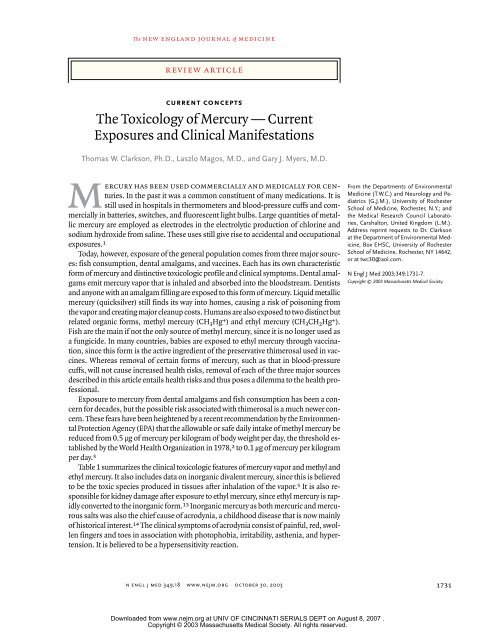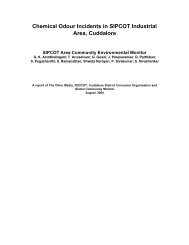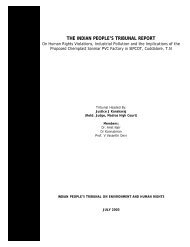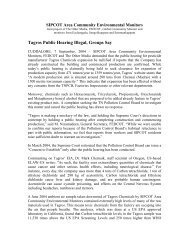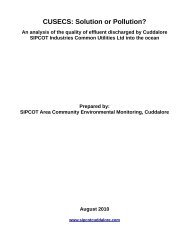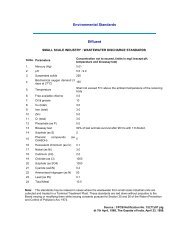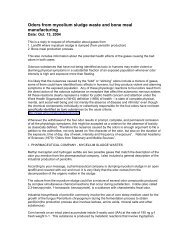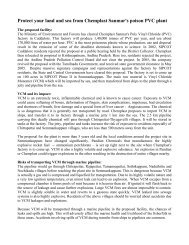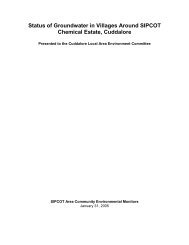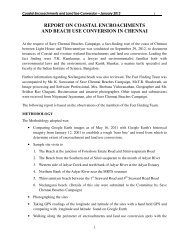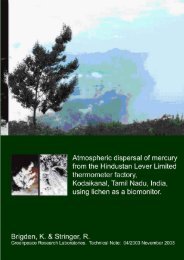The Toxicology of Mercury - SIPCOT Area Community ...
The Toxicology of Mercury - SIPCOT Area Community ...
The Toxicology of Mercury - SIPCOT Area Community ...
Create successful ePaper yourself
Turn your PDF publications into a flip-book with our unique Google optimized e-Paper software.
<strong>The</strong> new england journal <strong>of</strong> medicine<br />
review article<br />
current concepts<br />
<strong>The</strong> <strong>Toxicology</strong> <strong>of</strong> <strong>Mercury</strong> — Current<br />
Exposures and Clinical Manifestations<br />
Thomas W. Clarkson, Ph.D., Laszlo Magos, M.D., and Gary J. Myers, M.D.<br />
mercury has been used commercially and medically for centuries.<br />
In the past it was a common constituent <strong>of</strong> many medications. It is<br />
still used in hospitals in thermometers and blood-pressure cuffs and commercially<br />
in batteries, switches, and fluorescent light bulbs. Large quantities <strong>of</strong> metallic<br />
mercury are employed as electrodes in the electrolytic production <strong>of</strong> chlorine and<br />
sodium hydroxide from saline. <strong>The</strong>se uses still give rise to accidental and occupational<br />
exposures. 1<br />
Today, however, exposure <strong>of</strong> the general population comes from three major sources:<br />
fish consumption, dental amalgams, and vaccines. Each has its own characteristic<br />
form <strong>of</strong> mercury and distinctive toxicologic pr<strong>of</strong>ile and clinical symptoms. Dental amalgams<br />
emit mercury vapor that is inhaled and absorbed into the bloodstream. Dentists<br />
and anyone with an amalgam filling are exposed to this form <strong>of</strong> mercury. Liquid metallic<br />
mercury (quicksilver) still finds its way into homes, causing a risk <strong>of</strong> poisoning from<br />
the vapor and creating major cleanup costs. Humans are also exposed to two distinct but<br />
related organic forms, methyl mercury (CH 3 Hg + ) and ethyl mercury (CH 3 CH 2 Hg + ).<br />
Fish are the main if not the only source <strong>of</strong> methyl mercury, since it is no longer used as<br />
a fungicide. In many countries, babies are exposed to ethyl mercury through vaccination,<br />
since this form is the active ingredient <strong>of</strong> the preservative thimerosal used in vaccines.<br />
Whereas removal <strong>of</strong> certain forms <strong>of</strong> mercury, such as that in blood-pressure<br />
cuffs, will not cause increased health risks, removal <strong>of</strong> each <strong>of</strong> the three major sources<br />
described in this article entails health risks and thus poses a dilemma to the health pr<strong>of</strong>essional.<br />
Exposure to mercury from dental amalgams and fish consumption has been a concern<br />
for decades, but the possible risk associated with thimerosal is a much newer concern.<br />
<strong>The</strong>se fears have been heightened by a recent recommendation by the Environmental<br />
Protection Agency (EPA) that the allowable or safe daily intake <strong>of</strong> methyl mercury be<br />
reduced from 0.5 µg <strong>of</strong> mercury per kilogram <strong>of</strong> body weight per day, the threshold established<br />
by the World Health Organization in 1978, 2 to 0.1 µg <strong>of</strong> mercury per kilogram<br />
per day. 3<br />
Table 1 summarizes the clinical toxicologic features <strong>of</strong> mercury vapor and methyl and<br />
ethyl mercury. It also includes data on inorganic divalent mercury, since this is believed<br />
to be the toxic species produced in tissues after inhalation <strong>of</strong> the vapor. 5 It is also responsible<br />
for kidney damage after exposure to ethyl mercury, since ethyl mercury is rapidly<br />
converted to the inorganic form. 13 Inorganic mercury as both mercuric and mercurous<br />
salts was also the chief cause <strong>of</strong> acrodynia, a childhood disease that is now mainly<br />
<strong>of</strong> historical interest. 14 <strong>The</strong> clinical symptoms <strong>of</strong> acrodynia consist <strong>of</strong> painful, red, swollen<br />
fingers and toes in association with photophobia, irritability, asthenia, and hypertension.<br />
It is believed to be a hypersensitivity reaction.<br />
From the Departments <strong>of</strong> Environmental<br />
Medicine (T.W.C.) and Neurology and Pediatrics<br />
(G.J.M.), University <strong>of</strong> Rochester<br />
School <strong>of</strong> Medicine, Rochester, N.Y.; and<br />
the Medical Research Council Laboratories,<br />
Carshalton, United Kingdom (L.M.).<br />
Address reprint requests to Dr. Clarkson<br />
at the Department <strong>of</strong> Environmental Medicine,<br />
Box EHSC, University <strong>of</strong> Rochester<br />
School <strong>of</strong> Medicine, Rochester, NY 14642,<br />
or at twc30@aol.com.<br />
N Engl J Med 2003;349:1731-7.<br />
Copyright © 2003 Massachusetts Medical Society.<br />
n engl j med 349;18 www.nejm.org october 30, 2003<br />
1731<br />
Downloaded from www.nejm.org at UNIV OF CINCINNATI SERIALS DEPT on August 8, 2007 .<br />
Copyright © 2003 Massachusetts Medical Society. All rights reserved.
<strong>The</strong> new england journal <strong>of</strong> medicine<br />
Table 1. <strong>The</strong> Major Clinical Toxicologic Features <strong>of</strong> <strong>Mercury</strong>.*<br />
Variable <strong>Mercury</strong> Vapor Inorganic Divalent <strong>Mercury</strong> Methyl <strong>Mercury</strong> Ethyl <strong>Mercury</strong><br />
Route <strong>of</strong> exposure Inhalation Oral Oral (from fish<br />
consumption)<br />
Target organ<br />
Local clinical signs<br />
Lungs<br />
Gastrointestinal<br />
tract<br />
Central nervous system, peripheral<br />
nervous system, kidney<br />
Bronchial irritation, pneumonitis<br />
(>1000 µg/m 3 <strong>of</strong> air)<br />
Metallic taste, stomatitis, gingivitis,<br />
increased salivation<br />
(>1000 µg/m 3 <strong>of</strong> air)<br />
Parenteral (through<br />
vaccines)<br />
Kidney Central nervous system Central nervous<br />
system, kidney<br />
Metallic taste, stomatitis,<br />
gastroenteritis<br />
Skin<br />
Urticaria, vesication<br />
Systemic clinical signs<br />
Kidney Proteinuria (>500 µg/m 3 <strong>of</strong> air) Proteinuria, tubular necrosis Tubular necrosis<br />
Peripheral nervous<br />
system<br />
Peripheral neuropathy (>500<br />
µg/m 3 <strong>of</strong> air)<br />
Acrodynia<br />
Acrodynia<br />
Central nervous<br />
system<br />
Approximate half-life<br />
(whole body)<br />
(days)<br />
Treatment‡<br />
Erethism (>500 µg/m 3 <strong>of</strong> air),<br />
tremor<br />
Paresthesia, ataxia, visual<br />
and hearing loss (>200<br />
µg/liter <strong>of</strong> blood)<br />
60 40 70 20†<br />
Meso-2,3-dimercaptosuccinic<br />
acid<br />
Meso-2,3-dimercaptosuccinic<br />
acid<br />
Chelators not effective§<br />
Paresthesia, ataxia,<br />
visual and hearing<br />
loss<br />
Chelators not<br />
effective§<br />
* Data were adapted from Gossel and Bricker. 4 Clinical manifestations vary with the degree and length <strong>of</strong> exposure. <strong>The</strong> values in parentheses are<br />
the approximate range <strong>of</strong> mercury concentration in air (expressed as micrograms per cubic meter) and in blood (expressed as micrograms per<br />
liter) associated with the onset <strong>of</strong> clinical signs and symptoms. Epidemiologic studies that did not use specific end points such as IQ score indicate<br />
a risk <strong>of</strong> adverse effects (approximately 5 percent) at lower concentrations (e.g., 25 to 50 µg <strong>of</strong> mercury vapor per cubic meter and 40 µg<br />
<strong>of</strong> methyl mercury per liter <strong>of</strong> blood are associated with an increased risk <strong>of</strong> prenatal damage to the developing central nervous system). 3,5 In<br />
general, the atmospheric concentration <strong>of</strong> mercury vapor equals the urinary concentration. <strong>The</strong> mean urinary concentration in the U.S. general<br />
population is 0.72 µg per liter (95 percent confidence interval, 0.6 to 0.8), and the mean blood concentration is 0.34 µg per liter (95 percent confidence<br />
interval, 0.3 to 0.4). 6 In Europe 7 and other parts <strong>of</strong> the world, 8 blood concentrations appear to be somewhat higher. <strong>The</strong> mean urinary<br />
concentrations increase according to the number <strong>of</strong> dental amalgam surfaces, and blood concentrations increase according to the level <strong>of</strong> fish<br />
consumption. 6 No reliable data are available on the concentration <strong>of</strong> inorganic divalent mercury associated with adverse effects.<br />
† <strong>The</strong> half-life in blood is about 20 days in adults but may be as short as 7 days in infants.<br />
‡ Details <strong>of</strong> meso-2,3-dimercaptosuccinic acid treatment have been published. 9-11<br />
§ Chelators can remove methyl and ethyl mercury from the body; they cannot reverse the damage to the central nervous system. <strong>The</strong>y may, however,<br />
prevent further deterioration. 12<br />
more heated around 1970 with the discovery that<br />
amalgams can release mercury vapor into the oral<br />
cavity in concentrations that are higher than those<br />
deemed safe by occupational health guidelines.<br />
Subsequently, it was realized that the actual inhaled<br />
dose was small, owing to the small volume <strong>of</strong><br />
the oral cavity. Nevertheless, amalgam fillings are<br />
the chief source <strong>of</strong> exposure to mercury vapor in the<br />
general population. 8 Brain, blood, and urinary concentrations<br />
correlate with the number <strong>of</strong> amalgam<br />
surfaces present. It has been estimated that 10 amalgam<br />
surfaces would raise urinary concentrations by<br />
1 µg <strong>of</strong> mercury per liter, roughly doubling the backmercury<br />
vapor<br />
from dental amalgams<br />
Dental amalgams have been in use for over 150<br />
years. <strong>The</strong>y are inexpensive and thought to be more<br />
durable and easier to use than other types <strong>of</strong> fillings.<br />
<strong>The</strong> amalgam consists <strong>of</strong> approximately 50 percent<br />
mercury combined with other metals such as silver<br />
and copper. Since their introduction, dental amalgams<br />
have been a source <strong>of</strong> controversy because <strong>of</strong><br />
the assumed health risks <strong>of</strong> mercury. <strong>The</strong> arguments<br />
between the protagonists and antagonists have<br />
been referred to as the “amalgam wars” and became<br />
1732<br />
n engl j med 349;18 www.nejm.org october 30, 2003<br />
Downloaded from www.nejm.org at UNIV OF CINCINNATI SERIALS DEPT on August 8, 2007 .<br />
Copyright © 2003 Massachusetts Medical Society. All rights reserved.
current concepts<br />
ground concentrations. 15 Higher urinary concentrations<br />
are found in persons who chew a great deal.<br />
For example, the long-term use <strong>of</strong> nicotine chewing<br />
gum will raise urinary concentrations close to occupational<br />
health limits. 16 <strong>The</strong> removal <strong>of</strong> amalgam<br />
fillings can also cause temporary elevations in blood<br />
concentrations, 17 since the process transiently increases<br />
the amount <strong>of</strong> mercury vapor inhaled.<br />
What is the health risk from such exposures?<br />
Cases <strong>of</strong> poisoning from inhalation <strong>of</strong> mercury vapor<br />
have been recognized for centuries. 18 Severe<br />
cases are characterized by a triad <strong>of</strong> intentional<br />
tremor, gingivitis, and erethism (Table 1). Erethism<br />
consists <strong>of</strong> bizarre behavior such as excessive shyness<br />
and even aggression. <strong>The</strong> Mad Hatter in Alice in<br />
Wonderland was probably a victim <strong>of</strong> occupational<br />
mercury intoxication.<br />
Today’s occupational exposures, such as in the<br />
dental <strong>of</strong>fice, are lower and may lead to mild, reversible<br />
effects on the kidney or mild cognitive changes<br />
and memory loss. 5 However, urinary concentrations<br />
in people with amalgams (about 2 to 4 µg <strong>of</strong> mercury<br />
per liter) are well below concentrations found in<br />
people who are occupationally exposed to mercury<br />
(20 to 50 µg <strong>of</strong> mercury per liter) unless they are<br />
also excessive chewers. Current concern arises from<br />
claims that long-term exposure to low concentrations<br />
<strong>of</strong> mercury vapor from amalgams either causes<br />
or exacerbates degenerative diseases such as amyotrophic<br />
lateral sclerosis, Alzheimer’s disease, multiple<br />
sclerosis, and Parkinson’s disease. Speculation<br />
has been most intense with respect to Alzheimer’s<br />
disease after a report that the brains <strong>of</strong> patients with<br />
Alzheimer’s disease had elevated mercury concentrations.<br />
However, several epidemiologic investigations<br />
failed to provide evidence <strong>of</strong> a role <strong>of</strong> amalgam<br />
in these degenerative diseases, including a<br />
long-term study <strong>of</strong> 1462 women in Sweden, 19 an<br />
ongoing Swedish twin study involving 587 subjects,<br />
20 and a study <strong>of</strong> 129 nuns 75 to 102 years <strong>of</strong><br />
age, which included eight tests <strong>of</strong> cognitive function.<br />
21 Nevertheless, in vitro studies have indicated<br />
that mercury can affect the biochemical processes<br />
believed to be involved in Alzheimer’s disease. 22 <strong>The</strong><br />
problem is that mercury can inhibit various biochemical<br />
processes in vitro without having the same<br />
effect in vivo.<br />
Patients who have questions about the potential<br />
relation between mercury and degenerative diseases<br />
can be assured that the available evidence shows no<br />
connection. Some will ask whether their mercury<br />
fillings should be removed. <strong>The</strong>y should be reminded<br />
that the process <strong>of</strong> removal generates mercury<br />
vapor and that blood concentrations will subsequently<br />
rise substantially before they eventually decline.<br />
17 <strong>The</strong>re is no clear evidence supporting the<br />
removal <strong>of</strong> amalgams.<br />
exposure in adults<br />
Cases <strong>of</strong> severe, even fatal, methyl mercury poisoning<br />
date back to the 1860s in England, when such<br />
mercurials were first synthesized. 28 Subsequent<br />
cases arose through occupational and dietary exposures.<br />
Several large outbreaks were caused by the<br />
consumption <strong>of</strong> bread mistakenly made from methyl<br />
mercury–coated seed grain; for example, an outmercury<br />
vapor from<br />
quicksilver in the home<br />
Recent attempts by power companies to replace<br />
pressure-control devices for the domestic gas supply<br />
have led to spills <strong>of</strong> liquid mercury, affecting<br />
some 200,000 homes in one incident. 23 Spills <strong>of</strong><br />
liquid mercury in the home carry a risk <strong>of</strong> vapor inhalation.<br />
Quicksilver is an attractive play object for<br />
children and is found in many homes, especially in<br />
developing countries. High levels <strong>of</strong> exposure to<br />
mercury vapor can result from the cultural and religious<br />
use <strong>of</strong> elemental mercury, including sprinkling<br />
mercury on the floor <strong>of</strong> a home or car, burning<br />
it in a candle, and mixing it with perfume. 24<br />
Infants and young children, whose breathing<br />
zones are closest to the floor, are at highest risk,<br />
since mercury vapor is heavy and tends to form layers<br />
close to the floor. Ingested liquid mercury passes<br />
through the gastrointestinal tract essentially unabsorbed.<br />
Centuries ago a tablespoonful <strong>of</strong> quicksilver<br />
was used to treat constipation. 25 It arguably represents<br />
one <strong>of</strong> the first uses <strong>of</strong> gravity in medicine.<br />
methyl mercury<br />
Among humans, the sole source <strong>of</strong> exposure to<br />
methyl mercury is the consumption <strong>of</strong> fish and sea<br />
mammals. Methyl mercury is produced environmentally<br />
by biomethylation <strong>of</strong> the inorganic mercury<br />
present in aquatic sediments (Fig. 1). It accumulates<br />
in the aquatic food chain and reaches its<br />
highest concentrations in long-lived, predatory fish<br />
such as swordfish and shark in the oceans and pike<br />
and bass in fresh water. Concentrations <strong>of</strong> mercury<br />
in ambient air and water are too low to pose a serious<br />
risk to the general population.<br />
n engl j med 349;18 www.nejm.org october 30, 2003<br />
1733<br />
Downloaded from www.nejm.org at UNIV OF CINCINNATI SERIALS DEPT on August 8, 2007 .<br />
Copyright © 2003 Massachusetts Medical Society. All rights reserved.
<strong>The</strong> new england journal <strong>of</strong> medicine<br />
Figure 1. <strong>The</strong> Global Cycle <strong>of</strong> <strong>Mercury</strong>.<br />
In nature, mercury vapor (Hg 0 ), a stable monatomic gas,<br />
evaporates from the earth’s surface (both soil and water)<br />
and is emitted by volcanoes (Panel A). Anthropogenic<br />
sources include emissions from coal-burning power stations<br />
and municipal incinerators. After approximately<br />
one year, mercury vapor is converted to a soluble form<br />
(Hg 2+ ) and returned to the earth in rainwater. It may be<br />
converted back to the vapor form both in soil and in water<br />
by microorganisms and reemitted into the atmosphere.<br />
Thus, mercury may recirculate for long periods.<br />
<strong>Mercury</strong> attached to aquatic sediments is subject to microbial<br />
conversion to methyl mercury (MeHg), whereupon<br />
it enters the aquatic food chain. It reaches its highest<br />
concentrations in long-lived predatory fish, such as<br />
sharks. Panel B indicates the routes <strong>of</strong> transformation to<br />
methyl mercury as originally suggested by Jernelöv. 26<br />
Panel C depicts the increase in mercury concentrations<br />
in feathers <strong>of</strong> fish-eating birds in Sweden. 27 <strong>The</strong> period<br />
covered by these data corresponds approximately to the<br />
growth <strong>of</strong> industrialization in Sweden.<br />
break in 1971 and 1972 in Iraq caused hundreds <strong>of</strong><br />
deaths and thousands <strong>of</strong> cases <strong>of</strong> severe intoxication.<br />
29 <strong>The</strong> industrial release <strong>of</strong> methyl mercury into<br />
Minamata Bay and the Agano River in Japan resulted<br />
in the accumulation <strong>of</strong> the toxicant in fish and, subsequently,<br />
in two large epidemics related to fish consumption.<br />
30 Overt cases <strong>of</strong> poisoning are now rare.<br />
In the United States, the only reported cases in the<br />
past 35 years involved a family that consumed the<br />
meat <strong>of</strong> a pig fed treated grain 31 and a university<br />
pr<strong>of</strong>essor who was accidentally exposed in the laboratory.<br />
11<br />
<strong>The</strong> brain is the primary target tissue. Adults<br />
present with paresthesias <strong>of</strong> the circumoral area and<br />
hands and feet, followed by visual-field constriction<br />
and ataxia. Neuropathological examination reveals<br />
regional destruction <strong>of</strong> neurons in the visual cortex<br />
and cerebellar granule cells. <strong>The</strong>re is usually a latent<br />
period <strong>of</strong> weeks or months between exposure and<br />
the onset <strong>of</strong> symptoms.<br />
Several studies have reported statistical associations<br />
between cardiovascular disease and mercury,<br />
mostly in the form <strong>of</strong> methyl mercury. One study<br />
found a direct relation between mercury concentrations<br />
and the risk <strong>of</strong> myocardial infarction, 32 whereas<br />
a nested case–control study <strong>of</strong> more than 300,000<br />
health pr<strong>of</strong>essionals found no such association. 33<br />
A third study, from eastern Finland, where the consumption<br />
<strong>of</strong> saturated animal fat is high, found an<br />
association, but the authors suggested that their<br />
finding might be specific to the region. 34,35 A fourth<br />
A <strong>The</strong> Global Cycle <strong>of</strong> <strong>Mercury</strong><br />
B Exposure to <strong>Mercury</strong> from Fish<br />
MeHg<br />
<strong>Mercury</strong> in Feathers (µg/kg)<br />
15<br />
10<br />
5<br />
0<br />
MeHg<br />
Osprey<br />
Diphenyl-Hg<br />
Phenyl-Hg +<br />
Elemental Hg<br />
Hg 2+<br />
Hg2+<br />
sediment<br />
Hg 0 Hg 2+<br />
Hg 0<br />
Hg 0 Hg 0 Hg 2+<br />
Hg 2+ Hg 0<br />
C Increase in <strong>Mercury</strong> in Fish-Eating Birds<br />
Biomethylation<br />
Great crested grebe<br />
Dimethyl-Hg<br />
Methyl-Hg +<br />
1840 1865 1890 1915 1940 1965<br />
Year<br />
study among seven-year-old children on the Faeroe<br />
Islands found that blood pressure was increased<br />
when the blood mercury concentration was below<br />
10 µg per liter but not when it was higher. 36 “Contrary<br />
to expectation,” as the authors stated, “this association<br />
occurred within an exposure range characteristic<br />
<strong>of</strong> communities not depending on marine<br />
food” such as the United States. 37 <strong>The</strong>y also pointed<br />
1734<br />
n engl j med 349;18 www.nejm.org october 30, 2003<br />
Downloaded from www.nejm.org at UNIV OF CINCINNATI SERIALS DEPT on August 8, 2007 .<br />
Copyright © 2003 Massachusetts Medical Society. All rights reserved.
current concepts<br />
out that “the average birth weight in this fishing<br />
community is the highest in the world and therefore<br />
the community may represent a unique setting.”<br />
Thus, firm conclusions about cause and effect<br />
cannot be yet made, since cardiovascular disease has<br />
multiple risk factors (e.g., family history, stress, dietary<br />
habits, smoking, alcohol use, diabetes, and socioeconomic<br />
status). <strong>The</strong> researchers themselves<br />
recognize this complication and use extensive statistical<br />
measures to correct for these factors. Prospective<br />
studies are needed to settle this issue. 38<br />
prenatal exposure<br />
<strong>The</strong> fetal brain is more susceptible than the adult<br />
brain to mercury-induced damage. Methyl mercury<br />
inhibits the division and migration <strong>of</strong> neuronal cells<br />
and disrupts the cytoarchitecture <strong>of</strong> the developing<br />
brain. In the past 15 years or so, epidemiologic studies<br />
have focused on the effects <strong>of</strong> prenatal exposure.<br />
39-41 As a consequence <strong>of</strong> these epidemiologic<br />
data, the EPA reduced the allowable intake <strong>of</strong> methyl<br />
mercury from 0.5 to 0.1 µg <strong>of</strong> mercury per kilogram<br />
per day. 42 This threshold is lower than those used by<br />
other regulatory agencies. Moreover, it translates<br />
into a weekly consumption <strong>of</strong> one 198-g (7-oz) can<br />
<strong>of</strong> tuna for an adult. Given that canned tuna is the<br />
cheapest and most widely consumed fish in the<br />
United States and is approved by the American Heart<br />
Association as part <strong>of</strong> a diet low in saturated fat and<br />
cholesterol, the debate over the safety <strong>of</strong> tuna and<br />
fish in general will continue with some intensity.<br />
It is reassuring that the only clinical reports <strong>of</strong><br />
mercury poisoning from fish consumption are<br />
those from Japan in the 1950s and 1960s. 8 <strong>The</strong> EPA<br />
guideline is derived from reports <strong>of</strong> subtle and<br />
small neuropsychological changes in children in the<br />
Faeroe Islands study, whose exposure was mainly<br />
from whale consumption. 36 A similar study in the<br />
Seychelles found no adverse effects from fish consumption<br />
alone. 41 <strong>The</strong> majority <strong>of</strong> the general population<br />
in the United States has levels <strong>of</strong> exposure<br />
well below the EPA guideline, but 8 percent or so<br />
have levels that are slightly higher. Although a National<br />
Academy <strong>of</strong> Sciences committee reported that<br />
60,000 children in the United States were at risk as<br />
a result <strong>of</strong> prenatal exposure, 43 they failed to provide<br />
any justification or explanation for that conclusion.<br />
Fish consumption has clear health benefits, and<br />
the risk posed by exposure to mercury is currently<br />
speculative. <strong>The</strong> Food and Drug Administration<br />
has recommended that pregnant women, nursing<br />
mothers, and young children avoid eating fish with<br />
a high mercury content (>1 ppm), such as shark,<br />
swordfish, tilefish, and king mackerel. Because<br />
whale meat contains up to 3 ppm <strong>of</strong> mercury, about<br />
half <strong>of</strong> which is in the form <strong>of</strong> methyl mercury, 44<br />
consumption <strong>of</strong> whale meat should also be discouraged.<br />
thimerosal in vaccines<br />
Thimerosal has been used as a preservative in many<br />
vaccines since the 1930s. 45,46 At concentrations<br />
found in vaccines, thimerosal meets the requirements<br />
for a preservative set forth by the U.S. Pharmacopeia<br />
47 — that is, it kills the specified challenge<br />
organisms and can prevent the growth <strong>of</strong> the challenge<br />
fungi. It contains the ethyl mercury radical<br />
(CH 3 CH 2 Hg + ) attached to the sulfur group <strong>of</strong><br />
thiosalicylate and is believed to behave toxicologically<br />
like other ethyl mercury compounds. Early toxicity<br />
studies found no adverse health effects; recently,<br />
however, Ball et al. reevaluated thimerosal by<br />
applying the revised EPA guideline for methyl mercury<br />
to ethyl mercury. 48 <strong>The</strong>y calculated that infants<br />
undergoing the usual U.S. program <strong>of</strong> vaccines from<br />
birth to six months <strong>of</strong> age would receive more than<br />
0.1 µg <strong>of</strong> mercury per kilogram per day. 8 Steps were<br />
rapidly taken to remove thimerosal from vaccines<br />
by switching to single-dose vials that did not require<br />
any preservative. This process is now virtually complete<br />
in the United States. <strong>The</strong> decision itself is remarkable,<br />
and the speed <strong>of</strong> execution even more<br />
so 49 ; however, the EPA guideline is based on epidemiologic<br />
data on prenatal exposure to methyl mercury<br />
rather than postnatal exposure to ethyl mercury.<br />
Ethyl mercury has some similarities to methyl<br />
mercury. <strong>The</strong>y are closely related chemically, have a<br />
similar initial distribution in the body, and cause<br />
similar types <strong>of</strong> damage to the brain in toxic doses.<br />
<strong>The</strong>y also have differences. Methyl mercury is<br />
more potent. Ethyl mercury is metabolized more<br />
rapidly to inorganic mercury; perhaps this is why<br />
ethyl mercury, unlike methyl mercury, causes kidney<br />
damage in humans. Of greater importance is the recent<br />
finding that the half-life <strong>of</strong> ethyl mercury in<br />
the body is much shorter. 50 <strong>The</strong> half-life <strong>of</strong> methyl<br />
mercury in blood, which is assumed to indicate the<br />
total body burden, is usually assumed to be about<br />
50 days. 51 In contrast, in children receiving thimerosal<br />
in vaccines, the half-life <strong>of</strong> ethyl mercury in<br />
blood was 7 to 10 days, or 1 ⁄7 to 1 ⁄5 as long as that <strong>of</strong><br />
methyl mercury. 50 <strong>The</strong>refore, in the two-month periods<br />
between vaccinations (at birth and at two,<br />
n engl j med 349;18 www.nejm.org october 30, 2003<br />
1735<br />
Downloaded from www.nejm.org at UNIV OF CINCINNATI SERIALS DEPT on August 8, 2007 .<br />
Copyright © 2003 Massachusetts Medical Society. All rights reserved.
<strong>The</strong> new england journal <strong>of</strong> medicine<br />
four, and six months), all <strong>of</strong> the mercury should have<br />
been excreted, so that there is no accumulation.<br />
Given the short half-life <strong>of</strong> ethyl mercury, any<br />
risks <strong>of</strong> its damaging either the brain or kidneys<br />
would seem remote. A World Health Organization<br />
advisory committee recently concluded that it is safe<br />
to continue using thimerosal in vaccines. 52 This is<br />
especially important in developing countries, where<br />
the use <strong>of</strong> a preservative is essential in multidose<br />
vials. <strong>The</strong> known risk <strong>of</strong> infectious diseases far exceeds<br />
that <strong>of</strong> the hypothetical risk <strong>of</strong> thimerosal.<br />
Claims have been made that thimerosal in vaccines<br />
may be a cause <strong>of</strong> autism and related disorders, but<br />
studies testing that theory have yet to be performed.<br />
All forms <strong>of</strong> mercury have adverse effects on<br />
health at high doses. However, the evidence that<br />
exposure to very low doses <strong>of</strong> mercury from fish<br />
consumption, the receipt <strong>of</strong> dental amalgams, or<br />
thimerosal in vaccines has adverse effects is open<br />
to wide interpretation. Moreover, attempts to reduce<br />
such exposure may pose greater health risks than<br />
those hypothesized to occur from mercury.<br />
Supported by grants (R01 ES10219 and P30 ES01247) from the<br />
National Institute <strong>of</strong> Environmental Health Sciences, National Institutes<br />
<strong>of</strong> Health.<br />
We are indebted to Helena King and Joyce Morgan for assistance<br />
with the figure.<br />
references<br />
1. Toxicological pr<strong>of</strong>ile for mercury. Atlanta:<br />
Agency for Toxic Substances Disease<br />
Registry, 1999.<br />
2. Evaluation <strong>of</strong> certain food additives and<br />
contaminants: twenty-second report <strong>of</strong> the<br />
Joint FAO/WHO Expert Committee on Food<br />
Additives. World Health Organ Tech Rep Ser<br />
1978;631:1-39.<br />
3. Environmental Protection Agency. Reference<br />
dose for chronic oral exposure to<br />
methylmercury. Greenbelt, Md.: Integrated<br />
Risk Information System, 2001.<br />
4. Gossel TA, Bricker JD. Principles <strong>of</strong> clinical<br />
toxicology. 2nd ed. New York: Raven<br />
Press, 1990.<br />
5. Inorganic mercury. Vol. 118 <strong>of</strong> Environmental<br />
health criteria. Geneva: World Health<br />
Organization, 1991.<br />
6. Second national report on human exposure<br />
to environmental chemicals. Atlanta:<br />
Centers for Disease Control and Prevention,<br />
2003. (Accessed October 6, 2003, at http://<br />
www.cdc.gov/exposurereport/.)<br />
7. Brune D, Nordberg GF, Vesterberg O,<br />
Gerhardsson L, Wester PO. A review <strong>of</strong> normal<br />
concentrations <strong>of</strong> mercury in human<br />
blood. Sci Total Environ 1991;100:235-82.<br />
8. Methylmercury. Vol. 101 <strong>of</strong> Environmental<br />
health criteria. Geneva: World Health<br />
Organization, 1990.<br />
9. Forman J, Moline J, Cernichiari E, et al.<br />
A cluster <strong>of</strong> pediatric metallic mercury exposure<br />
cases treated with meso-2,3-dimercaptosuccinic<br />
acid (DMSA). Environ Health Perspect<br />
2000;108:575-7.<br />
10. Bluhm RE, Bobbitt RG, Welch LW, et al.<br />
Elemental mercury vapour toxicity, treatment,<br />
and prognosis after acute, intensive exposure<br />
in chloralkali plant workers. I. History,<br />
neuropsychological findings and chelator<br />
effects. Hum Exp Toxicol 1992;11:201-10.<br />
11. Nierenberg DW, Nordgren RE, Chang<br />
MB, et al. Delayed cerebellar disease and<br />
death after accidental exposure to dimethylmercury.<br />
N Engl J Med 1998;338:1672-6.<br />
12. Pfab R, Muckter H, Roider G, Zilker T.<br />
Clinical course <strong>of</strong> severe poisoning with thiomersal.<br />
J Toxicol Clin Toxicol 1996;34:453-<br />
60.<br />
13. Magos L, Brown AW, Sparrow S, Bailey<br />
E, Snowden RT, Skipp WR. <strong>The</strong> comparative<br />
toxicology <strong>of</strong> ethyl- and methylmercury. Arch<br />
Toxicol 1985;57:260-7.<br />
14. Warkany J, Hubbard DM. Acrodynia and<br />
mercury. J Pediatr 1953;42:365-86.<br />
15. Kingman A, Albertini T, Brown LJ. <strong>Mercury</strong><br />
concentrations in urine and whole blood<br />
associated with amalgam exposure in a US<br />
military population. J Dent Res 1998;77:461-<br />
71.<br />
16. Sallsten G, Thoren J, Barregard L, Schutz<br />
A, Skarping G. Long-term use <strong>of</strong> nicotine<br />
chewing gum and mercury exposure from<br />
dental amalgam fillings. J Dent Res 1996;75:<br />
594-8.<br />
17. Molin M, Bergman B, Marklund SL,<br />
Schutz A, Skerfving S. <strong>Mercury</strong>, selenium,<br />
and glutathione peroxidase before and after<br />
amalgam removal in man. Acta Odontol<br />
Scand 1990;48:189-202.<br />
18. Ramazzini B. Diseases <strong>of</strong> workers.<br />
Wright WC, trans. New York: Hafner Publishing,<br />
1964.<br />
19. Ahlqwist M, Bengtsson C, Lapidus L,<br />
Gergdahl IA, Schutz A. Serum mercury concentration<br />
in relation to survival, symptoms,<br />
and disease: results from the prospective<br />
population study <strong>of</strong> women in Gothenburg,<br />
Sweden. Acta Odontol Scand 1999;57:168-<br />
74.<br />
20. Bjorkman L, Pedersen NL, Lichtenstein<br />
P. Physical and mental health related to dental<br />
amalgam fillings in Swedish twins. <strong>Community</strong><br />
Dent Oral Epidemiol 1996;24:260-7.<br />
21. Saxe SR, Snowdon DA, Wekstein MW, et<br />
al. Dental amalgam and cognitive function in<br />
older women: findings from the Nun Study.<br />
J Am Dent Assoc 1995;126:1495-501.<br />
22. Leong CC, Syed NI, Lorscheider FL. Retrograde<br />
degeneration <strong>of</strong> neurite membrane<br />
structural integrity <strong>of</strong> nerve growth cones<br />
following in vitro exposure to mercury. Neuroreport<br />
2001;12:733-7.<br />
23. Gibson R, Taylor TS. Nicor says mercury<br />
spilled at more sites: contamination found<br />
at 6 new locations, company tells state. Chicago<br />
Tribune (Sports Final Edition Section,<br />
zone N). September 14, 2000:1.<br />
24. Riley DM, Newby CA, Leal-Almeraz TO,<br />
Thomas VM. Assessing elemental mercury<br />
vapor exposure from cultural and religious<br />
practices. Environ Health Perspect 2001;109:<br />
779-84.<br />
25. Goldwater LJ. <strong>Mercury</strong>: a history <strong>of</strong><br />
quicksilver. Baltimore: York Press, 1972.<br />
26. Jernelöv A. Conversion <strong>of</strong> mercury compounds.<br />
In: Miller MW, Berg GG, eds. Chemical<br />
fallout: current research on persistent<br />
pesticides. Springfield, Ill.: Charles C Thomas,<br />
1969:68-74.<br />
27. Johnels AG, Westermark T. <strong>Mercury</strong><br />
contamination <strong>of</strong> the environment in Sweden.<br />
In: Miller MW, Berg GG, eds. Chemical<br />
fallout: current research on persistent pesticides.<br />
Springfield, Ill.: Charles C Thomas,<br />
1969:221-41.<br />
28. Hunter D. <strong>The</strong> diseases <strong>of</strong> occupations.<br />
4th ed. London: English Universities Press,<br />
1969:314-28.<br />
29. Bakir F, Damluji SF, Amin-Zaki L, et al.<br />
Methylmercury poisoning in Iraq. Science<br />
1973;181:230-41.<br />
30. Eto K, Oyanagi S, Itai Y, Tokunaga H,<br />
Takizawa Y, Suda I. A fetal type <strong>of</strong> Minamata<br />
disease: an autopsy case report with special<br />
reference to the nervous system. Mol Chem<br />
Neuropathol 1992;16:171-86.<br />
31. Likosky WH, Hinman AR, Barthel WF.<br />
Organic mercury poisoning, New Mexico.<br />
Neurology 1970;20:401.<br />
32. Guallar E, Sanz-Gallardo MI, van’t Veer<br />
P, et al. <strong>Mercury</strong>, fish oils, and the risk <strong>of</strong> myocardial<br />
infarction. N Engl J Med 2002;347:<br />
1747-54.<br />
33. Yoshizawa K, Rimm EB, Morris JS, et al.<br />
<strong>Mercury</strong> and the risk <strong>of</strong> coronary heart disease<br />
in men. N Engl J Med 2002;347:1755-<br />
60.<br />
34. Salonen JT, Seppanen K, Lakka TA, Salonen<br />
R, Kaplan GA. <strong>Mercury</strong> accumulation<br />
and accelerated progression <strong>of</strong> carotid atherosclerosis:<br />
a population-based prospective<br />
4-year follow-up study in men in eastern<br />
Finland. Atherosclerosis 2000;148:265-73.<br />
35. Salonen JT, Seppanen K, Nyyssonen K,<br />
et al. Intake <strong>of</strong> mercury from fish, lipid peroxidation,<br />
and the risk <strong>of</strong> myocardial infarc-<br />
1736<br />
n engl j med 349;18 www.nejm.org october 30, 2003<br />
Downloaded from www.nejm.org at UNIV OF CINCINNATI SERIALS DEPT on August 8, 2007 .<br />
Copyright © 2003 Massachusetts Medical Society. All rights reserved.
current concepts<br />
tion and coronary, cardiovascular, and any<br />
death in eastern Finnish men. Circulation<br />
1995;91:645-55.<br />
36. Sorensen N, Murata K, Budtz-Jorgensen<br />
E, Weihe P, Grandjean P. Prenatal methylmercury<br />
exposure as a cardiovascular risk<br />
factor at seven years <strong>of</strong> age. Epidemiology<br />
1999;10:370-5.<br />
37. Blood and hair mercury levels in young<br />
children and women <strong>of</strong> childbearing age —<br />
United States, 1999. JAMA 2001;285:1436-<br />
7.<br />
38. Bolger PM, Schwetz BA. <strong>Mercury</strong> and<br />
health. N Engl J Med 2002;347:1735-6.<br />
39. Kjellstrom T, Kennedy P, Wallis S, et al.<br />
Physical and mental development <strong>of</strong> children<br />
with prenatal exposure to mercury from<br />
fish. Stage 2. Interviews and psychological<br />
tests at age 6. Report no. 3642. Solna, Sweden:<br />
Solna National Swedish Environmental<br />
Board, 1989.<br />
40. Grandjean P, Weihe P, White RF, et al.<br />
Cognitive deficit in 7-year-old children with<br />
prenatal exposure to methylmercury. Neurotoxicol<br />
Teratol 1997;19:417-28.<br />
41. Myers GJ, Davidson PW, Cox C, et al.<br />
Prenatal methylmercury exposure from<br />
ocean fish consumption: 9-year evaluations<br />
in the Seychelles child development study.<br />
Lancet 2003;361:1686-92.<br />
42. Water quality criterion for the protection<br />
<strong>of</strong> human health: methylmercury. Washington,<br />
D.C.: Environmental Protection Agency,<br />
January 2001. (EPA-823-R-01-001.)<br />
43. Board on Environment studies and toxicology.<br />
Toxicological effects <strong>of</strong> methyl mercury.<br />
Washington, D.C.: National Research<br />
Council, 2000.<br />
44. Grandjean P, Weihe P, Jorgensen PJ,<br />
Clarkson T, Cernichiari E, Videro T. Impact<br />
<strong>of</strong> maternal seafood diet on fetal exposure to<br />
mercury, selenium, and lead. Arch Environ<br />
Health 1991;47:185-95.<br />
45. Magos L. Review on the toxicity <strong>of</strong> ethylmercury,<br />
including its presence as a preservative<br />
in biological and pharmaceutical preparations.<br />
J Appl Toxicol 2001;21:1-5.<br />
46. Clarkson TW. <strong>The</strong> three modern faces <strong>of</strong><br />
mercury. Environ Health Perspect 2002;110:<br />
Suppl 1:11-23.<br />
47. USP 24–NF 19: U.S. Pharmacopeia and<br />
national formulary. 24th ed. Rockville, Md.:<br />
United States Pharmacopeial Convention,<br />
1999.<br />
48. Ball LK, Ball R, Pratt RD. An assessment<br />
<strong>of</strong> thimerosal use in childhood vaccines. Pediatrics<br />
2001;107:1147-54.<br />
49. Freed GL, Andreae MC, Cowan AE, Katz<br />
SL. <strong>The</strong> process <strong>of</strong> public policy formulation:<br />
the case <strong>of</strong> thimerosal in vaccine. Pediatrics<br />
2002;109:1153-9.<br />
50. Pichichero ME, Cernichiari E, Lopricato<br />
J, Treanor J. <strong>Mercury</strong> concentrations and<br />
metabolism in infants receiving vaccines<br />
containing thiomersal: a descriptive study.<br />
Lancet 2002;360:1737-41.<br />
51. Smith J, Farris FF. Methyl mercury pharmacokinetics<br />
in man: a reevaluation. Toxicol<br />
Appl Pharmacol 1996;137:245-52.<br />
52. Vaccines and biologicals: recommendations<br />
from the Strategic Advisory Group <strong>of</strong><br />
Experts. Wkly Epidemiol Rec 2002;77:305-<br />
12.<br />
Copyright © 2003 Massachusetts Medical Society.<br />
full text <strong>of</strong> all journal articles on the world wide web<br />
Access to the complete text <strong>of</strong> the Journal on the Internet is free to all subscribers. To use this Web site, subscribers should go to<br />
the Journal’s home page (www.nejm.org) and register by entering their names and subscriber numbers as they appear on their<br />
mailing labels. After this one-time registration, subscribers can use their passwords to log on for electronic access to the entire<br />
Journal from any computer that is connected to the Internet. Features include a library <strong>of</strong> all issues since January 1993 and<br />
abstracts since January 1975, a full-text search capacity, and a personal archive for saving articles and search results <strong>of</strong> interest.<br />
All articles can be printed in a format that is virtually identical to that <strong>of</strong> the typeset pages. Beginning six months after publication,<br />
the full text <strong>of</strong> all Original Articles and Special Articles is available free to nonsubscribers who have completed a brief registration.<br />
n engl j med 349;18 www.nejm.org october 30, 2003<br />
1737<br />
Downloaded from www.nejm.org at UNIV OF CINCINNATI SERIALS DEPT on August 8, 2007 .<br />
Copyright © 2003 Massachusetts Medical Society. All rights reserved.


